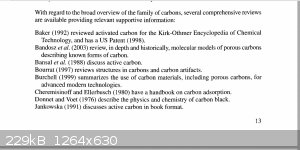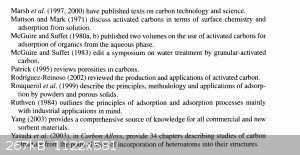Sorry to jump in, I am looking at AC for different reason, what I did find out was normally AC is done at 850C-1200C.
Then steam/water is injected or Co2 or Steam and Co2.
I also got info on Calcium Chloride, but will get to that later.
The activation is done at the same time as making the charcoal, industrially this is apparently done is huge rotating drums, common amounts are to end
up with 1/3rd material you start with.
From what I could make out (will locate and place links at end), the material (coconut favored,or HARD wood) is heated fairly rapidly, the atmosphere
is inert or close to it, the material is still at the stage it is gassifying or giving material off.
Steam and CO2 are then injected into the vessel, this is supposed to react with the material and make the pores inside the material larger, it is also
supposed to remove all tars/gums and resins.
This bit makes sense to me, even if you carbonize something, some of the chemical content will also be carbonized? and therefore become part of the
matrix in the carbon.
injection of steam and CO2 clears all this out, there was a warning of increase of out gas during this. The material produced (AC) apparently will
bubble when placed in water, the internal cavities are the highest in number of the processes.
Next we have low temp activation. Before going into this I will point out the following, the temperature matters and the point of injection seems to
matter, the method used seems to dictate the internal structure pore size.
Cold temp process
I found 2 versions of this with calcium chloride, first one is pretty much as aga did. the second one however injected calcium chloride once the
material or vessel with the material in, reached 250C.
It was said several times that it cant be done in a home oven, the 'home' options all used cans with tiny hole in tin can top (1-2 mm). This bit didnt
make sense so i will explain the info.
One was a video and one was from a commercial manufacture description, they didnt match up in all details.
First of all at no point does the tin seem to be opened, so how would anything be injected? I assume in this case the home making guide had actually
soaked the material, the professional guide mentions however injecting the calcium chloride once gassing commences.
I also found phosphoric acid etc mentioned, but again in all cases these were used before the material had been turned into charcoal. The other thing
I found was constant reference to packing as much material in as possible, activation or completion is assumed once no further gas emits from the tiny
hole.
I am looking into magnetic charcoal, this is to do with my bio fuel obsession. Anyway I will post what i find on the charcoal process here, any full
papers i will put in the normal place.
I hope this helps someone else, thx to aga for linking me back to this thread and the initial experiment. I am after a way of removing ultra fine
carbon with magnetic carbon, my application is purely about getting rid of discoloration.
I will post and come back in a few mins with the links.
I got bored watching this, but around 15.50 onwards, the guy explains a couple of things. This is a manufacturer of carbon products.
EDIT
At 24.45 he starts talking about activating carbon after its been made into carbon. While this goes against alot of reading, the process he mentions
does fit with what I had read.
So in this instance i think he is talking about the cold (250C) process, where the carbon is placed in an air excluded drum and rotated, this is
heated to 250C and water/steam is injected.
Hw talks about this 'carving' out the internal structure, to me this fits with the papers that talk about removing the volatiles that have carbonized.
[this is edit 3, hence why it slightly contradicts what i say bellow]
https://www.youtube.com/watch?v=1UPxYVemno8
Also i didnt find ANY mention of softwoods being used, hard and dense seemed to crop up most, i will edit with more links as I refind them. Sorry I
didnt keep all the links and papers as I was specifically looking for something else, then came back full circle.
[Edited on 5-11-2017 by NEMO-Chemistry]
This next video is from the same guy, i found this one contrary to alot of what I had read. In the first video i think its pretty clear he makes
things on a pro level, this video he is in his back yard making charcoal, also he mentions activating the carbon after it has been made. Now I unsure
here what to think, most the professional stuff I had read, indicated that activation was done at the time charcoal was made.
I also came across alot of information stating the charcoal is washed with extremely pure water to remove ash etc.
https://www.youtube.com/watch?v=3ii6S70bVY0&index=2&...
Sorry for constant edits, i am having to back track my browser history  . .
I have a book listed in mendeley i havnt read yet, its too big to post but i got it from normal sources.
Mash, H. and Rodríguez-Reinoso, F. (2006) Activated Carbon. doi: http://dx.doi.org/10.1016/B978-008044463-5/50022-4.
sorry this post has gone a bit all over the place! I had intended just to add some snipits I had found out, but on trying to locate them again, i have
come ac cross further information.
Sorry if some of what i said above is about to be contradicted!! I hadnt seen this further information at the time.
I have posted some screen shots from the book, these give further references related to activated carbon, i think aga was onto something, however i
think at the time the information he was working from was slightly off.
I have no idea if he intends to revisit this topic, but if not, maybe this extra info will help others. The book link dosnt work, but the intention is
merely to provide the name etc not a direct link to it.
One question that springs to mind, i am aware its likely the only way i will answer it though, is to do the experiment.
Alot of the activation is down to clearing out cells and gunk from the carbon, particularly in wood.
A thought occurred to me, while many of the processes inject steam etc to remove or etch the pore sizes, what about starting from drift wood?
I am sure everyone has seen the very old and grey driftwood, very very dry and hard, yet when broken in half it is mainly full of spaces, the contents
of cells etc long long gone.
Maybe driftwood could produce activated carbon without the need to activate it? after all the VO's etc have already been removed via osmosis. Just a
thought but its likely I will try and find out.. might be useful and quick for my purpose.
The only material I have found relating to this so far however, is papers regarding the high sodium and earth alkali metal content of driftwood. Maybe
beat up Carbon is not as simple as beaten up carbon after all.
Attached a paper on tests
Added a review paper on activated carbon methods
Added paper by Laine in refs EFFECT OF THE PREPARATION METHOD ON THE PORE SIZE DISTRIBUTION OF ACTIVATED CARBON
[Edited on 6-11-2017 by NEMO-Chemistry]
[Edited on 6-11-2017 by NEMO-Chemistry]
 
[Edited on 6-11-2017 by NEMO-Chemistry]
Attachment: Additive-006.pdf (133kB)
This file has been downloaded 493 times
[Edited on 6-11-2017 by NEMO-Chemistry]
Attachment: review.pdf (229kB)
This file has been downloaded 411 times
[Edited on 6-11-2017 by NEMO-Chemistry]
[Edited on 6-11-2017 by NEMO-Chemistry]
|